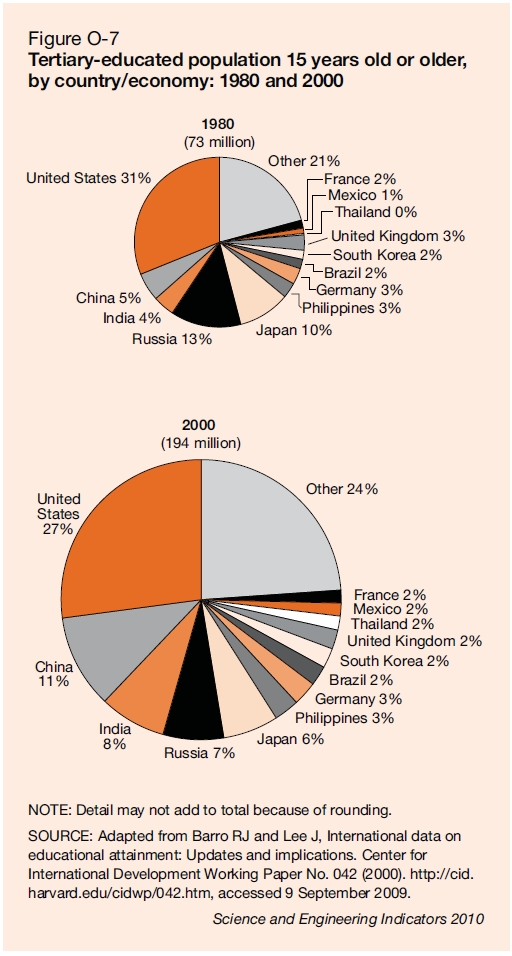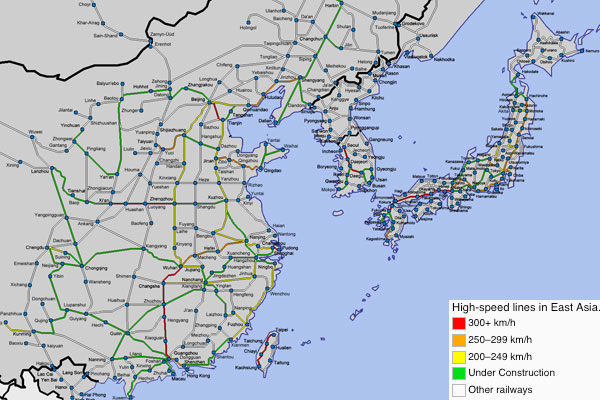As tired as that cliche is, India does need to wake up and smell the coffee. The world is moving on while India is still stuck in the socialist swamp created by the government after independence. I write this as a public service. I have no doubt that writing this for the edification of Indian policymakers is as useful as trying to teach a pig to sing (which as they say, cannot be done and it merely annoys the pig), but perhaps the general public will take note.
China, a country that was as poor as (if not poorer than) India merely 30 years ago, is no longer in the same minor league. India is generally grouped with tin-pot failed states such as Pakistan, while China these days is measured against the US. Or rather, the US is measured against the targets that China sets.
ITEM: TheScientist.com asks “Is America Competing?” and quotes data from a National Science Foundation (USA) report on Science and Engineering Data 2010.
At 1.47 million, the number of researchers in the United States is still the highest of all the regions surveyed, but the overall growth from 1995 to 2008 was 3%. The growth in number of researchers in China over the same period was 8.7%, with 1.42 million today, and no signs of slowing, . . .
● In terms of output, the US still leads the world in number of science and engineering publications per year, with nearly 209,000 in 2007. Still as a combined entity, the 27 countries in the EU produced the most with 245,000 publications.
● The US also still holds the world record for patents issued in 2007 at 82,000; the majority of those came from the biological sciences (50%). The second highest patent recipient is Japan with 34,600.
China appears to be all set to surpass the US in the near future. For now, China is fast pulling ahead of India. Note the gap between India and China increasing in tertiary education — as illustrated in the graphic below.
ITEM WorldFocus reports that China Commits Massive Funds to High Speed Rail
High-speed train travel is set to take over in China. New rail lines linking major cities are providing faster and faster routes for Chinese travelers.
China has committed almost $300 billion over the next decade to build the world’s most expansive network of high-speed trains, according to National Public Radio.
FT.com (Dec 27, 2009) reports China High-speed Train Sets New Record
China streaked ahead of its western and Asian rivals at the weekend by unveiling the world’s fastest long-distance passenger train service.
The Harmony express raced 1,100km in less than three hours on Saturday, travelling from Guangzhou, capital of southern Guangdong province, to the central city of Wuhan. The journey previously took at least 11 hours.
. . .
The Harmony express, which reached a top speed of 394km per hour in pre-launch trials, travelled at an average rate of 350km per hour on its debut. This compared with a maximum service speed of 300km per hour for Japan’s Shinkansen bullet trains and France’s TGV service. In America, Amtrak’s Acela “Express” service takes 3½ hours to trundle between Boston and New York, a distance of only 300km.
According to state media reports, the government spent $17bn (€12bn, £11bn) on the Harmony express line’s construction over 4½ years. Wuhan invested $2.4bn in a new French-designed train station, which boasts 20 tracks and 11 platforms. Officials this weekend declined to confirm project costs.
. . .
In total, the railways ministry intends to complete 18,000km of high-speed rail lines by 2012, allowing passengers to travel between most Chinese provincial capitals in eight hours or less.
One reason for the enormous construction outlay for the Harmony express was difficult terrain, especially in the poor mountainous areas of Guangdong and Hunan provinces. The train travels along 713km of elevated tracks and tunnels, accounting for about 70 per cent of its length.
The distance of 1,100 kms between Guangzhou and Wuhan is the same as between Mumbai and Delhi. The fastest train on that Indian line is the Rajdhani. It takes 18 hours compared to China’s 3 hours.
I have been promoting the idea that India has to have what I call an Integrated Rail Transportation System (July 2005) for a while.
The transportation system of an economy as geographically large, as densely populated, and as resource constrained as India’s, has to have as its backbone a rail transportation system.
Roads transportation is not an option for India for a number of obvious reasons. Cars and fossil fuels are expensive. Very efficient alternative fuel cars are even more expensive. With 17 percent of the world’s population and 2 percent of the world’s land area, we cannot afford the luxury of high speed expressways the way that the US can. We have to be more fuel efficient than the US because it is not even theoretically possible to emulate the US with its automobile/airlines system. The US appropriates approximately a quarter of the world’s total energy use with only about five percent of the world’s population. To reach US standards of energy use per capita, India would have to increase its energy consumption 25-fold. (NOTE: all figures in this piece are approximate. The exact figures will not substantially alter the argument.) [The IRTS — Revisited.]
But then, if India’s policymakers were smart enough to take good advice, India would not be so backward, would it?
Still I think that it is not too late for India. India needs leaders with vision, integrity, commitment and intelligence. What India has instead is a puppet on a string, and a puppet master who unfortunately does not have any vision that extends anything beyond personal gain. Indians do have the freedom to elect good leaders. How can one forget that India is the largest democracy! We are constantly reminded of that.
The world is also constantly reminded that India is the largest democracy. That it is a democracy appears to be the highest accolade India has any claim to. Paradoxically, this same badge is used as a shield for deflecting all criticism directed against India for its failure to develop.
The political leaders are criminals and crooks? Yeah, but India is a democracy! The children are malnourished? Yeah, yeah, but India is a democracy. Trains barely average 30 kms an hour? Sure, but India is a democracy. The most illiterates in the world? Never mind that, because India is a democracy. Liberalization of the economy is dragging on and the people are in economic shakles? So what, India is a democracy. Country being divided along religious and caste lines that is socially destabilizing and ruinous? Not an effing big deal because India is a democracy.
China racing ahead of India and lifting hundreds of millions out of poverty and educating them? That’s boring stuff because it is not a democracy.
Too bad that democracy does not fill one’s tummy.
It is all karma, neh?



Recently I read a news report in Rediff about the project estimates for high speed rail in India. I was surprised Japanese Shinkansen was not invited for contract bidding or estimates despite their trains being 30% longer and 30% wider compared to European counterparts (the 30% is from credible sources – my Japanese friends through conversations).
It was also mentioned that the costs we have to incur alarmingly high like in billions for hardly 1km. This was unbelievable to me. Not sure how the cost estimates were done.
That said initiating a high speed rail project can galvanize our economy. I am wondering if Govt lackadaisical approach is solely because of a possibility of losing monopoly over the existing Indian Railways. For HSR it needs a private partnership and Govt’s interference will be curtailed…
LikeLike
A very nice analysis. Yet, I had always felt that comparison with China should be seen in the context of our form of governance.
Don’t you think Communist form of governance is responsible for such fantastic growth? Whereas in India we have to go the slow process of Parliamentary approval. Don’t you think we are amply rewarded by our free culture in lieu of such rapid advancement?
What is your opinion regarding this?
LikeLike
Madhav:
No, I don’t think that it is the communist form of governance that is responsible for China’s growth. It has something to do with leadership and focus — which the current set of Indian “leaders” don’t have. If retarded growth had anything to do with democracy, then the US and other liberal western democracies demonstrate that democracy is not a sure fire guarantee of poverty and low growth; and if communism had anything to do with fast growth, then China would have been growing at this breakneck speed since 1960s, and the USSR would not have collapsed so spectacularly.
I think people are mistaken when they believe that there is a tradeoff between democracy and good economic performance. The fact is regardless of communism or democracy or capitalism or socialism, what matters is leadership. Rich comfortably off Indians love to think that low growth is alright because they (mistakenly) think that individual freedoms are bought at the cost of development. I don’t see that to be true. And even if it were true, it would be interesting to ask the 200 million malnourished children whether they like the tradeoff of their living a sub-human life so that the rich can have the luxury of debating the finer points of democracy.
LikeLike
Atanu Dey:
I do admit that when so many millions are is dire necessity of some basic requirements of life, it is callous to talk about “democratic ideals”.
However, there must be a philosophical base of any nation. Means are as important as results. Such tradeoff between good economic performance &democracy is what made communist nations commit excesses in the first place.
Anyway, when do you feel change will come upon us? When shall India progress China way?
LikeLike
Atanu
I think democracy is overrated. I mean, lets keep it in perspective: it is only one form of government among others.
It is certainly not the only one to have produced successful states; frankly, most democracies today are failures, if one looks at key indicators.
To my mind, saying that democracy is the only way is like saying christ is the only god. mindless preaching of democracy is nothing but monotheism.
And we’ve fallen for it hook, line and sinker. We need an alternate model; or, as you said, new rules, not new rulers.
LikeLike
Priceless! Chimdabaram are you listening….
LikeLike
Indian officials take a short sighted approach to governance. This is largely due to the insecurity around leadership and coalition politics. They’d rather implement populist measures that will win them the next election (Eg. loan waivers for farmers without distinguishing if it benefited a large landowner or a small farmer).
In a country like China where there is less insecurity about leadership, it is possible for the government to take a more long term strategic approach towards growth and development.
LikeLike